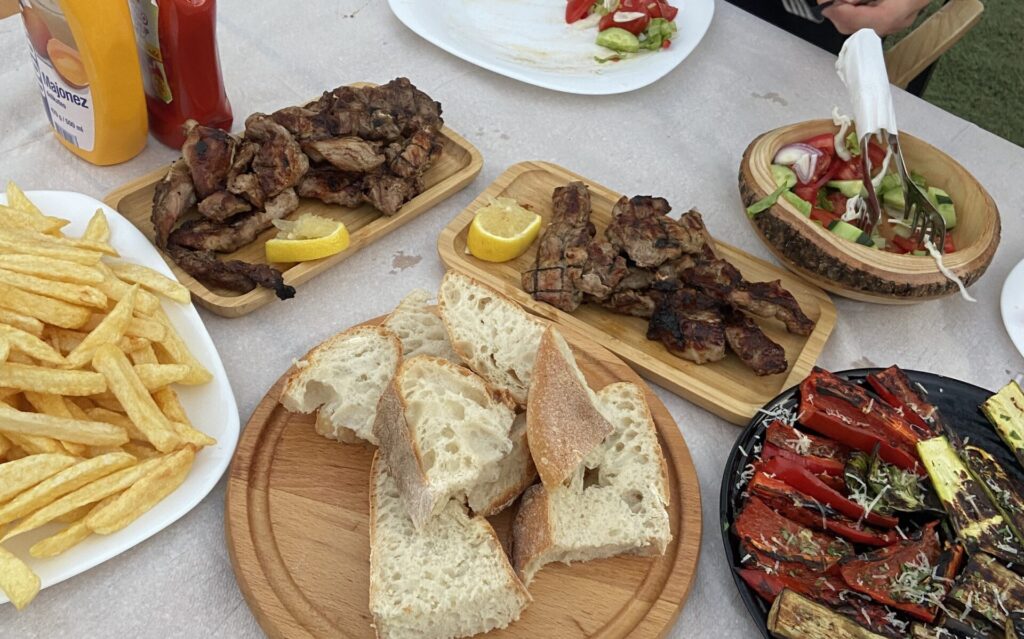How to Travel in and around Albania in 2024
I visited Albania twice this year. It has become one of my favourite countries I’ve ever visited. I would put this down to the culture created for backpackers in the hostels around the country, as well as the natural beauty, the value for money and the kindness of the Albanians. This post will help you plan your travels around Albania.
Albania is one of the Balkan countries. The Balkans has soared in popularity in recent years due to their value for money compared to other European holiday destinations. Albania is located between Montenegro and Greece and boasts a long coastline on the Adriatic Sea, which is part of the larger Mediterranean Sea. It is the best value for money in this region, partly due to the fact that it is not in the EU (yet!) and it has experienced a long history of economic difficulties. It is a poor country, especially by European standards, but what it lacks in wealth, it makes up for in experiences, natural beauty and welcoming people.
If you want to see each part of Albania and what they have to offer, then two-weeks is the minimum time I would recommend spending in this magnificent country. You can split the country into three sections: The North, Tirana and the hilly middle, and the Albanian Riviera.
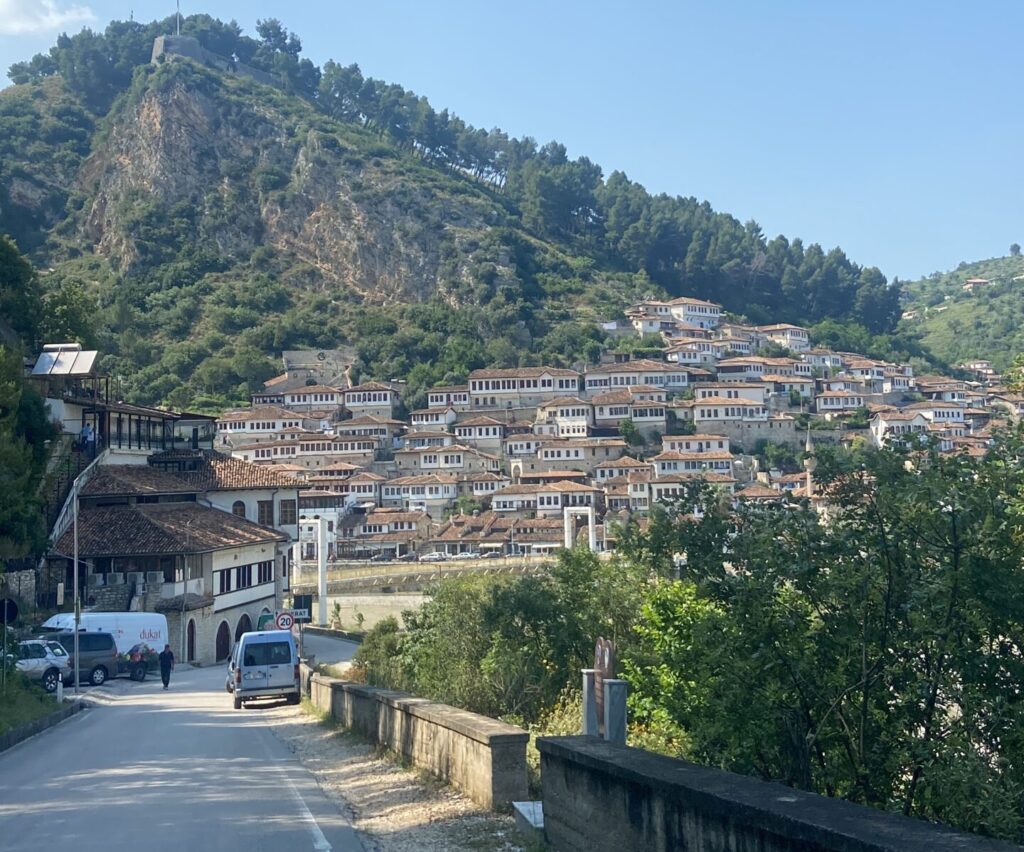
How to travel the north of Albania
You can access the North of Albania from Montenegro or Kosovo, or indeed from Tirana. Shköder is a city in the northwest of the country which provides an excellent jumping off point for exploring the north.
This city is located at Shködra lake, one of the largest lakes in the region. You can cycle to it from the city, where bikes are easily rented from your accommodation or a local bike shop for a low price. The lake is safe to swim in and hosts a diverse range of flora and fauna.
Organise the next step of your northern route from Shköder. Hostels will offer a package to hike from Theth to Valbonë or the other way around. They will organise the transport to and from Shköder but you will have to book your own accommodation in these places. I would recommend that you book these as soon as you know when you’ll be hiking there as they book up fast and are more expensive than accommodation usually is in Albania.
Pack a smaller bag that you will bring with you on your hike. You can leave the rest of your stuff in Shköder, usually with your accommodation. They shouldn’t charge you for this, but some do.
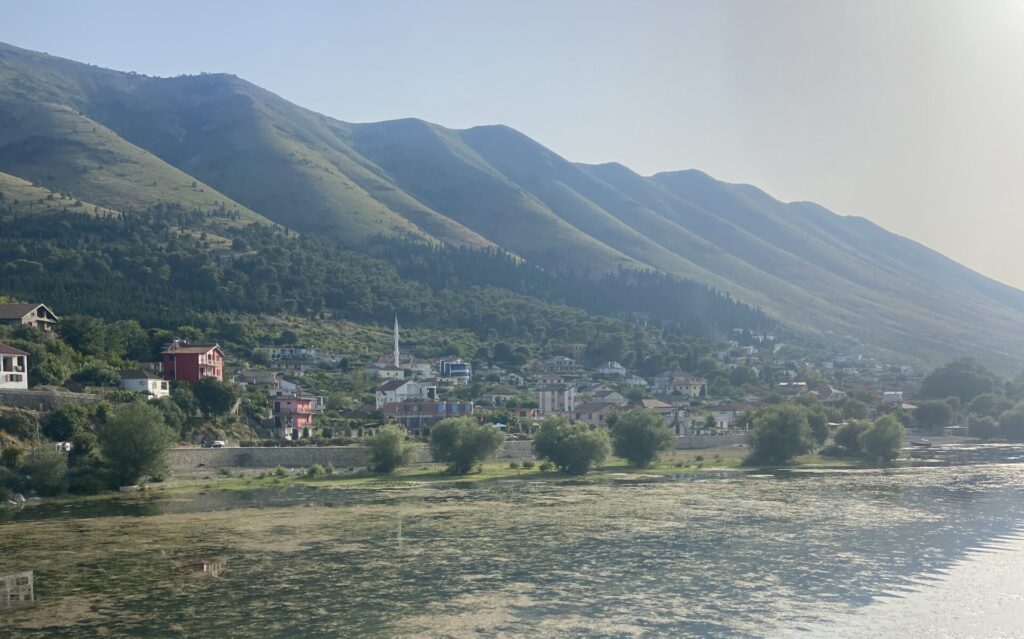
The itinerary for the few days should go like this:
Day 1
6:00am: Leave Shköder on a minibus bound for Theth or Valbonë (depending on which direction you choose!)
9:00am: Board a boat or continue on said bus to your first accommodation in Theth or Valbonë (they’ll drop you off if you aren’t really far from the village centres)
1:00pm: Arrive at your destination, chill out and relax as tomorrow is gonna be a tough one!
Day 2
7:00am: Get up bright and early and enjoy an Albanian traditional breakfast at your homestay (they will also provide you with enough extra ingredients to make sandwiches for lunch)
8:00am: Start your hike (if you’re staying outside of the town, I’d recommend getting brought to the start-point – your accommodation will organise this for you)
8:30am: Follow the markers to ensure you keep on the hike route – they’re red and white flags painted onto stones along the path
12:00pm: You’ll reach the peak of the hike around lunchtime. Take a rest and eat your packed lunch as you take in the views
2:00pm: You’ll pass a few small mountains bars where you can buy a coffee or a beer
4:00pm: You’ve done it! 18km later and you’re on the other side of the mountain!
5:00pm: Make your way to your accommodation – it could be a few km outside of the town so it is worth taking a taxi because you’ll only be climbing again!
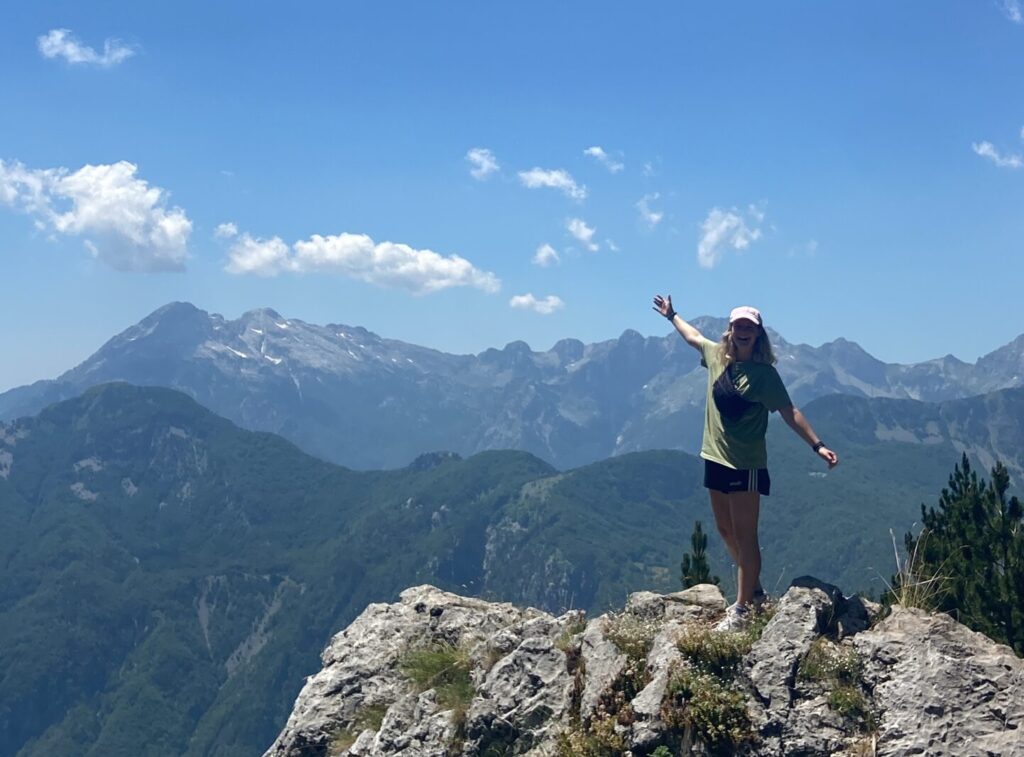
Day 3 etc.
The next day trekkers in Theth tend to either stay another night and visit the Blue Eye. If you’ve arrived in Valbonë you’ll have a long journey back to Shköder ahead of you. I was on a shoestring budget at this stage so I headed back to Shköder and only visited the river which is connected to the Blue Eye after my hike. The water was freezing cold but so refreshing after a day’s long hike. I didn’t even have any swimwear so I got in my clothes.
Accommodation
I stayed in Hostel Quku i Valbones in Valbonë and Bujtima Te Grima in Theth. Quku was great, Bujtima was a little underwhelming. Both breakfasts included with the stays were superb.
How to travel around Tirana and the Hilly Middle of Albania
Tirana is the capital of Albania. It is a small capital, home to about 700,000 people. There is an air of modernity about Tirana which you will not get anywhere else in the country. Here you can find specialty coffee, natural wine bars and chic Italian restaurants. You’ll probably be in Tirana a couple of times if you’re visiting both the north and the south of the country, as it hosts most bus connections.
Do a free walking tour from Skanderbeg Square to ground yourself in the country’s history, particularly its recent history which is terribly sad yet incredibly interesting. Armed with your new information, visit Bunk Art 1 or 2 to get a deeper understanding of their infamous dictator Enver Hoxha.
You can take mini-buses from the South Terminal to Berat and Gjirokaster. Both offer a similar ambience. I would recommend visiting both as I had an absolutely fantastic time exploring both these quaint villages. Stone City Hostel in Gjirokaster is one of the best hostels I’ve ever stayed at – a huge shout out to them.
Visit Skenduli House, an Ottoman-era family home. The owner of the home, which has stayed in the family for generations, gives you a tour for €3. It’s a great insight into the culture and traditions of the people in Albania at the time. The house itself is so well preserved.
You can also visit a Cold War Tunnel. I believe the tour cost around €2. The guide has a very dry sense of humour, perhaps lacking in enthusiasm, but it’s a very dark and dreary place so can you blame him? It’s freezing down there, so bring a jacket!
There is also a beer street in Gjirokaster, despite its small size. The local bars blast music and young backpackers and locals all sit outside drinking cocktails and beer.

Berat is closest to Tirana. There is an Ottoman-era castle on top of one of two hills which make up the village. Explore these hills, both of which are completely free of charge to do so. In the evening, take a walk along Berat main street. At sundown all the locals come out in the cool air for a walk and a chat with their neighbours. It is called Xhiro Hour and it’s one of the most unusual observations I made on my Albania trip. You will notice as you continue to talk through Albania that this habit is not exclusive to Berat!
Renting a car in Albania should cost you €40-€50/day. If you do rent a car, I would encourage you to visit the Hidden Blue Eye. I’ve marked it on a Google Map below. Chances are there will be no-one else there when you visit, as it is very off the beaten track. Blue Eyes are naturally occurring springs. They are so deep that they don’t even know how deep they are. Divers have only been able to go down 50m and not reach the bottom.
The water in the Blue Eyes around Albania is freezing cold, probably 1 or 2 degrees celsius. I would therefore advise with strong caution about swimming in the Blue Eyes. Do NOT dive straight in. You may get the shock of your life. The water comes from the mountains, some of which are covered in snow all year around, hence the cold temperatures.
I would also recommend you to visit the thermal baths in Përmet. You would need to drive to these yourself as there is no public transport to get here. They are sulphur thermal baths, located along a canyon. You can walk along the canyon and try out each of the natural baths! Each one is a different temperature! There is a beautiful old Ottoman bridge that connects the two sides of the canyon too.
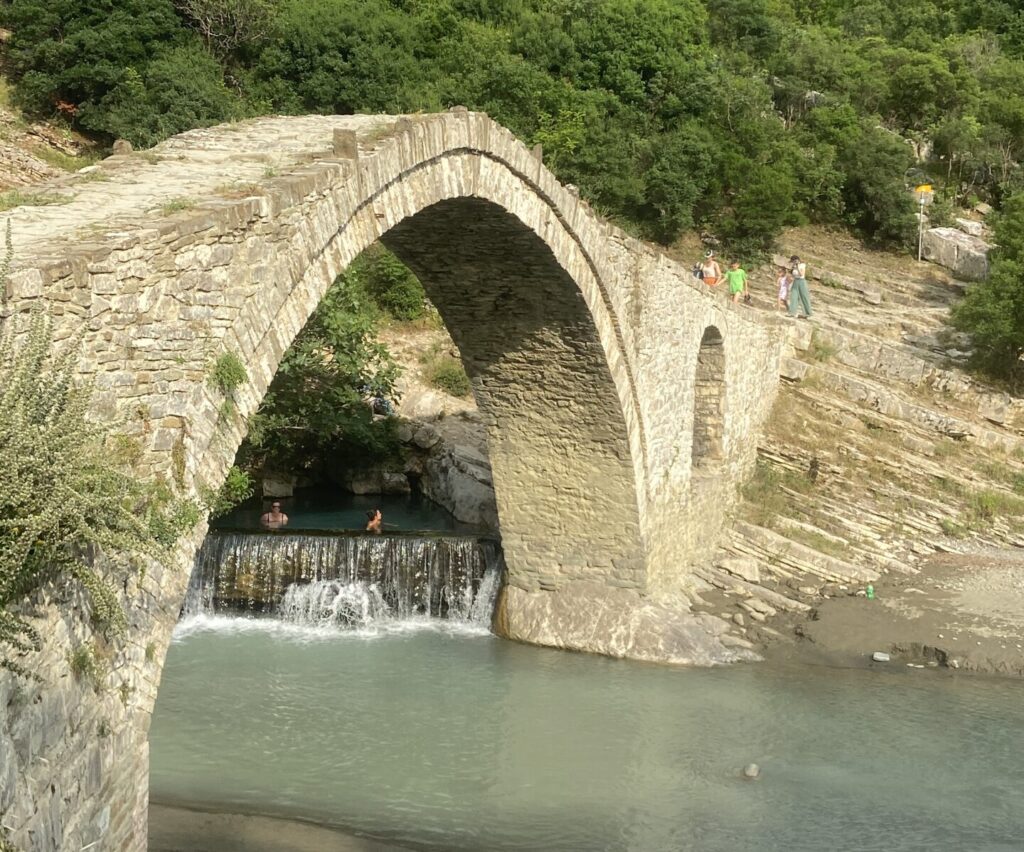
How to travel around the Albanian Riviera or South Coast and Beaches of Albania
With the beauty of a Greek coastline, for less than half the cost, the Albanian Riviera is becoming increasingly popular. I would implore you to visit as soon as you can. A suggested route could be Durrës, Florë, Sarandë and Ksamil. This will take you all along the Adriatic Coast.
As with any beach holiday, the options for activities are predictable – sun lounging, water sports, seafood restaurants and beach bars! This might be a nice way to round off your time in Albania as it is much slower paced. You will notice the prices to be slightly higher along the south coast of the country, due to the fact that it tends to draw the most tourists, so just be prepared for that.
General tips for travelling Albania in 2024
Cash and ATMs
I could count on one hand how many times a credit / debit card was accepted during my time in Albania. You must carry cash. They will accept euros, though you will lose out significantly as they tend to round up the exchange rate when you pay in euros. Pay in Albanian Lek wherever possible. It’s roughly 100 lek to a euro.
In a similar vein, as you’ll need cash, you’ll need to use ATMs. There’s a strategy here to save some money. Credins Bank offers the best deal. It was free to take out Albanian Lek from Credins for the majority of my time in Albania.
However, once tourist high season had come around, they introduced a charge of €6 per withdrawal, putting it on par with the rest of the banks in terms of ATM withdrawal fees. They are worth checking out to see if that’s just the case for July – August.
As Lek is a closed currency, you aren’t allowed to take it outside of the country, so you can’t exchange it when you get home (if you have extra). This also means that you cannot buy Lek before coming to Albania. It’s extremely inconvenient. I believe they will change to using Euros in the next couple of years so perhaps this won’t be an issue anymore.
Transport
The public bus network is a strange one. It’s run by young lads driving minibuses. They seem to stop wherever you want. You get on the bus and give them the cash payment at the end. It’s chaotic but entertaining. The country is quite well connected. You’ll pay between €3-€12 to get from place to place on one of these public buses.
The timetables change all of the time and they aren’t available online. They just seem to make them up day to day so it can be hard to plan. I would just check the latest timetable at the bus terminals when I arrived at a new destination. It can be a bit of luck too. It’s Albania, it can seem incredibly disorganised at times but it works.
Food and Drink
There won’t be much opportunity for any cuisine other than Albanian cuisine. Every menu is the same – chicken, pork, beef fillets or steaks served with some salad and chips (fries). There’s some very traditional authentic food. It is nice but I did get bored of it after a while as they don’t tend to like sauces much and I love sauce-based meals.
If you’re a vegetarian they always have stuffed aubergines and peppers on the menus. They are usually stuffed with rice and herbs, perhaps some feta too.
They also seem to love whipped ice-cream in Albania. You can get a ‘99 ice-cream’ for as cheap as 30c. They eat fried dough with white cheese for breakfast, or byrek (burek) which is common amongst many Eastern-European countries.
Coffee, beer and wine is cheap and available everywhere. Try their wine – it’s great! There’s a huge coffee culture here. The streets are lined with small family-run coffee shops. The more old Albanian mens sitting there slurping on an espresso, the cheaper the coffee. I never had a bad coffee in Albania.
